
Above: Lincoln Castle's Georgian gaol, with Lincoln Cathedral in the background.
He talked to her endlessly about his love of horizontals: how they, the great levels of sky and land in Lincolnshire, meant to him the eternality of the will, just as the bowed Norman arches of the church, repeating themselves, meant the dogged leaping forward of the persistent human soul, on and on, nobody knows where; in contradiction to the perpendicular lines and to the Gothic arch, which, he said, leapt up at heaven and touched the ecstasy and lost itself in the divine.
- D.H. Lawrence, Sons and Lovers (1913)
Another bank holiday weekend had rolled across the United Kingdom, blanketing the nation with the opportunity, nay, the duty of citizens to disgorge themselves from the uniform rows of terraced housing and ex-council or still-council flats, and engorge themselves with a mighty feast of weekend breaks, Euro-hops and dirty weekends in the country. Not being in a position to engage in any of those forms of recreation, I had barely recovered from the feat of organising the last bank holiday travels, and so was faced with yet another opportunity for European adventurism gone begging due to a lack of prior organisation.
Resorting to the time-honoured technique of leaving things as late as possible and then organising things in a rush, I decided to stay in England and try to visit a part of the country I’d not been to before. One drawcard in favour of Lincolnshire aside from not having been there before was the prospect of visiting Lincoln Cathedral: there has been a swathe of cathedral architecture programmes on BBC4 lately, and it has featured prominently due to its impressive prospect, dominating the entire city from the slopes. So, Lincoln for the long weekend it was.
But before that, Saturday was spent on the vital cultural pursuits and general messing about in London. This involved checking out the Telectroscope, going to see Son Of Rambow (‘…skill!’) and watching the ever-unfolding yet strangely unmissable travesty of light entertainment that is the Eurovision Song Contest. Once upon a time there was a proud British tradition of cheering Cliff Richard, Sandie Shaw or Lulu on to victory in Europe. But these days the taste barometer has swung firmly eastwards, and no country west of the former Iron Curtain has won since 2000. The very few points offered to the doughty UK performer, Andy ‘Former Bin-Man’ Abrahams left his restrained 70s soul number 'Even If' teetering in equal second-last place. In fact without a ringing endorsement from the voters of first-time Eurovision participant San Marino (population 30,000), the UK would have been dead last. Nothing like a bit of politics amidst the cheesy pop songs to keep the crowd entertained.
Back to the travelling! The northwards train was scheduled to depart from King’s Cross on Sunday morning, and with the usual sense of decorum the entire complement of hundreds of passengers were queued in a massive snaking coil running around the entire radius of the station. With five minutes to go until the train departed for Peterborough and all points north to Edinburgh (don’t miss your stop, d'ye ken?) the platform gates were opened and everyone scrambled to wedge themselves and their lumbering wheelie bags on board the train. In a happy miracle of constructive chaos, everyone more or less reached their correct seat and more or less stowed their luggage away, and the train was able to set off on time.
After a little over an hour and two stops the train reached the bleak platform at Newark North Gate, which is famous for precisely nothing, and is where I clambered out and waited for a connecting service on the branch line to Lincoln. After ten minutes a little two-carriage train rattled up and took aboard a dozen or two passengers for the 45 minute trip through the flat pastures of Lincolnshire to the county town, halfway between Newark and the North Sea coast.
As the train drew closer to my destination it was plain to see why the Romans picked out the site for a settlement – the ridgeline on which the old town is built is a rare outburst of altitude that dominates the plains of Lincolnshire. The Church knew a good thing when it saw it too, because atop this prominent ridge lies Lincoln’s greatest treasure – the proud jutting towers of Lincoln Cathedral, visible for miles around and a visible beacon for the whole county.
I collected my bag and walked from the train station up the High Street past all the bustling Sunday shoppers. Soon the gradient increased and the High Street became Steep Street, with its two 12th century houses and conveniently placed benches to rest upon if pedestrians tire themselves out. Reaching the crest of the hill I passed the cathedral on my right and the castle on my left and walked on through the Roman arch at the north end of the old town. (William the Conqueror would’ve ridden through this gate on his return from visiting far-flung York during the early years of his reign).

I reached my destination for the night, the Good Lane B&B – a cosy place with friendly proprietors. I deposited my bag in my room and ventured back into the town for some proper sightseeing.
The obvious first destination was the striking Lincoln Cathedral. William the Conqueror first ordered its construction, and with the later embellishment of a massive central spire it was reputedly the tallest building in the world from 1300 until 1549, when the spire blew down in a storm. It was never replaced, but the interior of the cathedral still tells the story of a town that was once England’s second wealthiest city.
Near the beautiful rain of colour of the cathedral’s east window in a prominent position lies the tomb of Eleanor of Castile, Queen of England, who died in nearby Harby in 1290.
Although Eleanor was buried in Westminster, the tomb in Lincoln Cathedral is said to contain her viscera (eww, etc.). It is from Eleanor that we have the name of Charing Cross in London, because her body was transported in daily stages from Lincoln to Westminster, and at each nightly resting place King Edward (the first; Edward Longshanks) erected a mourning cross. The last of these crosses was at Charing, which later became identified as Charing Cross, the notional centre of London.
While I explored the cathedral its choristers began practicing their hymns, sending ethereal notes wafting through the spacious environs.
I explored the chapter house with its impressive rose window, and the cloisters, where some suitably cruciform trelliswork caught my eye (see above). On the way out I was impressed by the rugged bulk of the Norman font adorned with carved dragons that was brought to the cathedral from Tournai in 1145. I’d been unable to get a close look on the way in because it was in use for a family christening, showing that Lincoln is still a busy working church for the local community.

Braving the ever-increasing showers of rain, I walked the short distance to Lincoln Castle, where according to Henry VIII’s courts, his fifth wife Catherine Howard carried on her affair with young courtier Thomas Culpeper. (This letter from Howard to Culpeper was later produced as evidence against them).
Once inside its impressive 12th century encircling walls I noticed an Roman cavalry exhibition on the castle green, by the Comitatus Roman re-enactment society. Four cavalry officers in a variety of equestrian armour and ten legionary infantrymen were putting on a display of Roman cavalry tactics for the small and rather soggy crowd. In the wet conditions the horses could spook easily, and one cavalryman was thrown from the saddle and was lucky to avoid being trodden on by his mount. They put on an entertaining demonstration of mounted archery and showed how horses could be trained to push their way through human obstacles, which would’ve been handy when an officer was running late for a hot date at the Forum.
The castle has an even longer history than the nearby cathedral. The Anglo-Saxon Chronicle reports this for the year 1067, the year after the Battle of Hastings gave William I the throne of England:
Then the king was informed that the people in the north were gathered together and meant to make a stand against him if came. He then went to Nottingham and built a castle there, and so went to York and there built two castles, and in Lincoln and everywhere in that district.
In one darkened room (absolutely no photos!) lies the castle’s most valuable possession: one of only four remaining copies of the original Magna Carta from 1215 (the other three are in the House of Lords, the British Museum and Salisbury Cathedral). This particular copy was on loan to the 1939 New York World Fair and was kept in Fort Knox for the duration of World War Two to keep it safe for future generations.
The castle served as a prison from 1787 until 1878, and at the heart of the Georgian gaol is the world’s only remaining separatist chapel. For a time in the 1840s and 50s inmates were not permitted to converse with each other at any time, and the chapel was constructed so that prisoners could only see the chaplain.
The emphasis of the separate system was firmly based on punishment rather than rehabilitation. The system denied the prisoners any human contact and male prisoners had to wear leather masks when outside their cells. They were also made to do endless tasks such as picking oakum (unravelling old ropes to make material for caulking the decks of ships) or cranking a screw within a bed of sand - prison warders got their derogatory name from this practice. Not surprisingly, many convicts went mad or attempted suicide under this regime.
Visitors to the castle can see the unique chapel in its original state - it did not change even after the discrediting of the 'separate system' in the 1850s. An ingenious arrangement meant that each prisoner occupied a seat contained by tall hinged screens. They filed into position one by one and then an officer could operate a mechanism that locked the screens in place, giving each prisoner a view of the pulpit and nothing else.
(Source: Lincolnshire County Council)
The chapel seats in each booth were even constructed at a 45 degree angle so the prisoners could not obtain any relaxation during the long sermons.
The castle was the site of many hangings, which were conducted in public until this practice was outlawed in 1868. One such case is reported in this flybill from 1822:
Perhaps Rogers was kept in this medieval cell before his execution.
After the public hanging he may well have been buried atop the ancient and lonely mound of the Lucy Tower, where tiny gravestones now mark the final resting places of criminals executed on the castle’s walls.

After some more wandering around Lincoln in the rain I retired to the B&B to watch Walk The Line on my very own little TV. A nice way to round out the day.
===
Bank holiday Monday dawned clearer and warmer than the day before, and after a lavish breakfast at the B&B I headed back down into town for further exploration. It was a better day to capture the beauty of the cathedral against a fresh blue sky, for one thing.
It was also a good opportunity to visit the ruined Bishop’s Palace next to the cathedral. Construction of the palace began here in the late 12th century, and English Heritage sums up its importance:
Standing almost in the shadow of Lincoln cathedral, with sweeping views over the ancient city and the countryside beyond, the medieval bishops' palace was once among the most important buildings in the country. The administrative centre of the largest diocese in medieval England, stretching from the Humber to the Thames, its architecture reflected the enormous power and wealth of the bishops as princes of the church.
The palace fell into disrepair in the aftermath of the Dissolution and the damage caused by the Civil War. Nowadays an excellent audio guide talks visitors through the many chambers and unroofed halls. The actor playing a priest on the audio guide explains in fruity, mellifluous tones how the palace worked in its heyday. And it was a place of real power – both Henry VIII and James I visited here.
After lunch I made my way to the train station for an afternoon visiting another Lincolnshire town – the former port of Boston. En route I was surprised to note that Lincolnshire children are remarkably well-behaved on public transport, at least compared to children in London, who are wont to caterwaul and litter whilst filling train carriages with the tinny ‘tsh-tsh’ of MP3s emanating from cheap mobile phones. Well, okay, Lincolnshire kids did the phone music thing too, but they were actually talking quietly amongst themselves while they did it. They used unheard-of words like ‘please’ and ‘thank you’ when addressing each other! To quote Ben Elton in ‘The Young Ones’:
Neil's Father: Now why couldn't you be in one of those nice situation comedies that your mother likes. Like, uh, what's the thing called...?
Vyvyan: Grange Hill!
Neil's Father: Yes! That's the one.
[Scene changes to School Corridor. Two school boys run in.]
Ben Elton: So that's settled. We'll organise a protest against school uniforms!
Spaz: Great! We can use the banners left over from the last protest we organised, so that racism wouldn't be an issue in this school.
Ben Elton: Good idea. I'll get Mucka, Ducka, Trucka and Sucka, and you get Spaz.
Spaz: But I am Spaz!
Ben Elton: Oh. I better get him as well then. Come on!
[They run into a teacher.]
Spaz: Oh! Sorry, Mr. Liberal. We were just on our way to...
Mr. Liberal: Now wait a minute, you two. Don't you realise that the way you act is influencing millions of children to talk Cockney and be insubordinate?
Ben Elton: Oh, come on, sir. We're the only kids in Britain who never say f—k!
Well, okay, they did actually say f—k, but only once or twice, and only in quite a genteel fashion. Wait, where was I before I went off on a tangent? Oh yes, Boston…
The town was once the second-wealthiest port in England after London, and it grew rich on the wool trade with Europe and the Baltic. Nowadays it’s a quiet country town of about 35,000, but it makes the most of its historic connections with America, because it was in Boston in 1607 that the men who would become the Pilgrim Fathers were tried and imprisoned. While this proved a major setback for their plans to emigrate to the New World to escape religious persecution, they were later joined in Massachusetts by economic migrants from the town, which gave its name to a settlement that would later become the metropolis of Boston (population approximately 4.3 million).
The town has preserved its old guildhall where the Pilgrim Fathers were tried, and it’s now decked out as an enjoyable small museum detailing the mercantile life of the town, its history as a courthouse and the brief appearance of the Pilgrims. On the ground floor there’s two small cells in which a plaque proclaims the Pilgrims were imprisoned, but it’s more likely they were banged up somewhere else in Boston, because some evidence suggests that the cells weren’t constructed until the 18th century. For an interesting backgrounder on the Pilgrims of 1607, see this article from the Smithsonian magazine in 2006.
Boston’s other main noteworthy site is its impressive church, St Botolph’s, which is better known as the ‘Boston Stump’ due to its lack of a spire. It was built from the 14th to the 16th century, and still evokes the Bostonian pride of the town’s wealthier days.
A memorial caught my eye – this stamped brass plaque to Richard Bolle, a former Sheriff of Lincolnshire who died aged 85 on 6 February 1591. This is probably the oldest memorial that I’ve seen in English – most of the earlier memorials to wealthy citizens are in Latin.
Soon enough it was time to return to Lincoln, so I boarded the train back to the town of Sleaford, where I waited for a tiny one-carriage train to trundle back up the line to Lincoln.

There I collected my bag and scoffed a quick bite of dinner at a Wetherspoon’s pub – my first visit to such an establishment since I’ve been back, if I remember correctly – and then began the journey back to the capital, having enjoyed explored a part of rural England rich in history and character.
eT
p.s. Okay, I confess that I haven't actually read 'Sons And Lovers'...
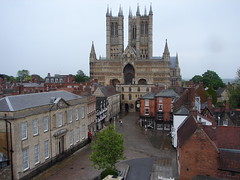



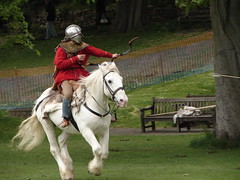
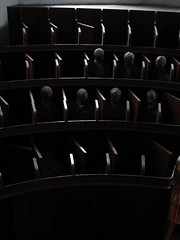
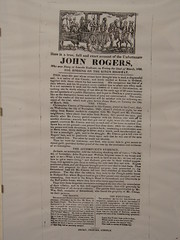
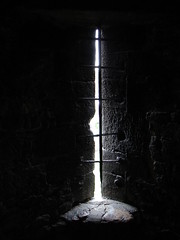
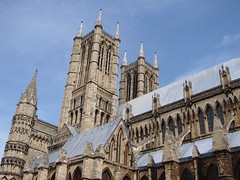
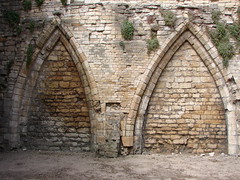
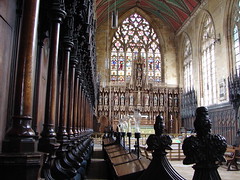

No comments:
Post a Comment